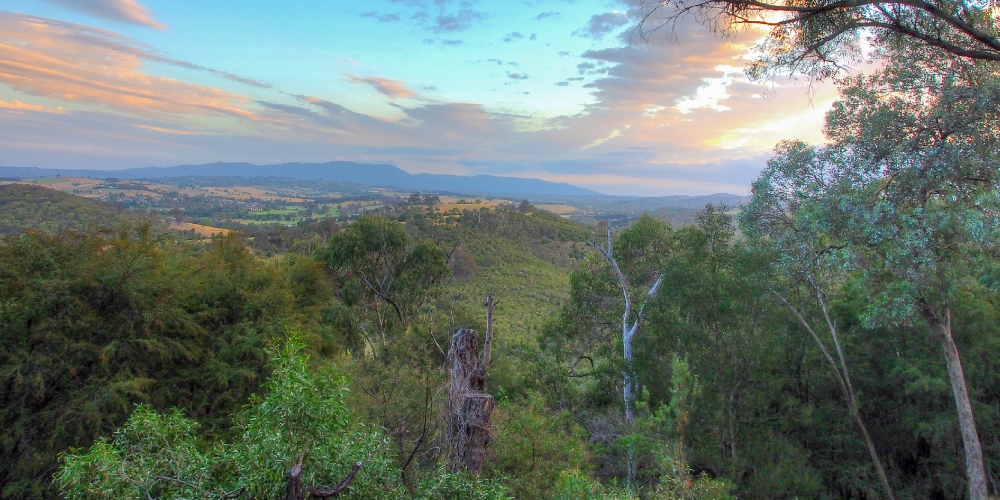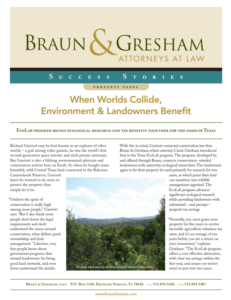EcoLab program brings ecological research and tax benefits together for the good of Texas
Richard Garriott may be best known as an explorer of other worlds – a god among video gamers, he was the world’s first second-generation space traveler and sixth private astronaut. But Garriott is also a lifelong environmental advocate and conservation activist here on Earth. So when he bought some beautiful, wild Central Texas land connected to the Balcones Canyonlands Preserve, Garriott knew he wanted to do more to protect the property than simply let it be.
“I believe the spirit of conservation is really high among most people,” Garriott says. “But I also think most people don’t know the legal requirements and don’t understand the issues around conservation, what defines good stewardship and land management.” Likewise, very few people know about government programs that reward landowners for being good land stewards, and even fewer understand the details.
With this in mind, Garriott contacted conservation law firm Braun & Gresham, where attorney Cassie Gresham introduced him to the Texas EcoLab program. The program, developed by and offered through Braun, connects conservation- minded landowners with university ecological researchers. The landowners agree to let their property be used primarily for research for two years, at which point their land can transition into wildlife management appraisal. The EcoLab program advances significant ecological research while providing landowners with substantial – and prompt – property tax savings.
“Normally, you must graze your property for five years to receive favorable agriculture valuation tax rates, and it’s an average of ten years before you see a return on your investment,” explains Gresham. “The EcoLab program offers a cost-effective alternative, with clear tax savings within the first year, and return-on-investment in just over two years.
Landowners often take some of their tax savings and make a charitable contribution to the university to help fund the research.
So that, along with legal services, is the upfront cost for property owners.”
Once a landowner is interested in the program, Gresham alerts Dr. Edward Theriot, Director of the Texas Natural Science Center and director of EcoLab at The University of Texas. Dr. Theriot posts the property information up online [www.texasecolab.org] and begins to solicit proposals from university researchers. Theriot reviews all research proposals from universities for scientific quality and budget compatibility, and gives a recommendation to Gresham regarding which properties and research projects may be well-matched. Gresham goes over eligible proposals with the landowner, and they select and approve research projects for their properties.
“What we offer landowners is turnkey representation and reassurance,” Gresham notes. “We’re a comprehensive operation – we recruit researchers, provide a legal framework for the relationship, do all the paperwork, file with the tax appraisal district, deal with any disputes that might come up, and coordinate with universities to make sure everything runs smoothly. We’ve got this unique combination of our relationship with the university, our experienced legal guidance, and our understanding of the landowner’s perspective.”
From researchers’ point of view, the program serves a vital purpose.
“In Texas in particular, about 97 percent of land is privately owned,” explains Dr. Theriot. “Because the land publicly available for research is mostly roadway rights-of-way, we’ve got some huge gaps in our knowledge of Texas ecology and biodiversity. It’s absolutely essential for scientists to have access to private lands with a diversity of habitats in order to get an accurate ‘big picture’ understanding of our environment.” Additionally, private lands provide security – researchers can put out equipment without the worry of vandalism – and offer limited access by others, so changes in the natural habitat can definitely be attributed to natural causes.
Since Braun & Gresham initiated the Texas EcoLab program in 2004, Gresham has made matches between more than 60 landowners and over 30 researchers representing nine universities. Typical research projects have included studies on the preservation and propagation of native plants, the effects of urbanization, and wildlife migration patterns.
Though landowners tend to find the program because they are seeking a wildlife management valuation, they seem to stay with the Ecolab program and continue to host researchers after they move to a wildlife management valuation because they love working with the researchers and learn a lot about their properties from the research.
“There’s definitely an inspirational factor involved in participation with the program,” Gresham asserts. “Landowners get really excited about the specialness of their property, and about supporting scientific research and education. Many keep on hosting research long after they’ve realized wildlife management status.” Richard Garriott – who, six years into the program, continues to host three research projects on his land – agrees wholeheartedly. Though the EcoLab program prefers properties with natural habitats of 50 acres or more, Garriott is quick to call attention to how individualized the program can be to meet landowner needs.
“Braun is brilliant at explaining what elements are important to being a good steward, defining what the legal requirements are, and listening to what will feel good to me, then presenting a palette of actionable items and potential budgets for making it all happen.”
“The best thing about a program like EcoLab is what a win it is at so many levels for all participants,” concludes Garriott. “My participation has given a good diversity of property that researchers needed, the protection for the land that I wanted, and has greatly increased my appreciation of my property. It’s intensified my personal connection to my land, while providing a positive regional or even statewide environmental impact. It’s just a clear win for everyone.”



